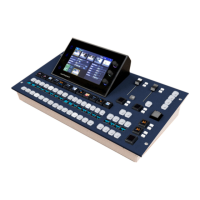193
Keying and DVE Operation
Keying
Keying Theory
Keying is the process of inserting a specific part of one video signal (Key signal) into another
video signal (background) to create a third signal. The Key signal has two jobs and may be one
signal or two. It has to cut a hole into the background and Fill that hole with a picture, or a
matte.
Where two signals are used one, the Key Cut, cuts the hole in the background and the other,
the Key Fill, Fills that hole. The Fill has to be shaped to match the hole.
Where one signal is used it both cuts and Fills the hole. This process of Keying with a single
signal is known as a self Key or video Key.
There are two types of Keying available with Masterpiece; they are Luma Keying and Linear
Keying.
Linear Keying
Linear Keying is used where the Key signal is already Keyed, i.e., the area outside the required
video is at black level. It is also used where there are separate Key Cut and Key Fill signals. The
Key signal(s), (Cut and Fill) are usually anti-aliased (soft edged) shaped signals created by a
character generator or graphics system.
Luma Keying
Luma Keying is a Keying system that is typically used on sources that are not pre-Keyed, such as
those from a camera. The Key Cut signal is generated from the video signal using lift and gain
controls. The portions of the signal that is lower in luminance than the lift level cut the hole in
the Key Layer.
The Key lift and gain levels are user adjustable.
The Fill may be the Grass Valleye source as the Cut or from a different source, or matte
generator. When only one source is used for both Key Fill and Key Cut the Key is called a Self
Key or a Video Key.

